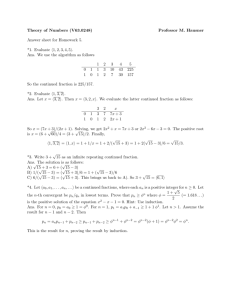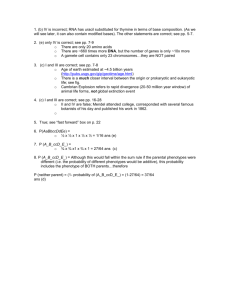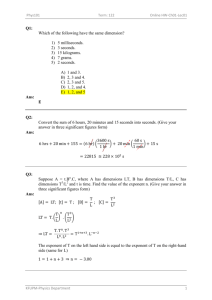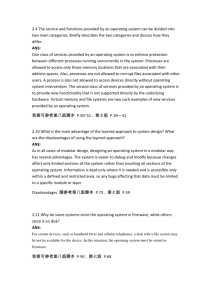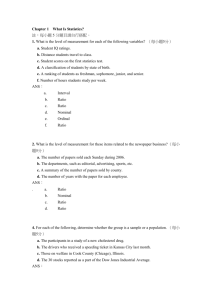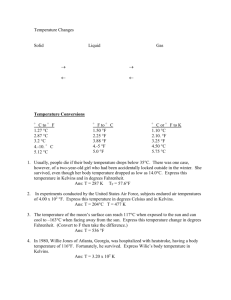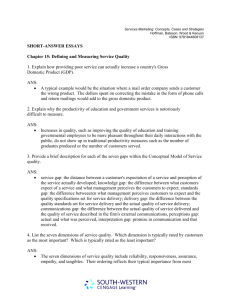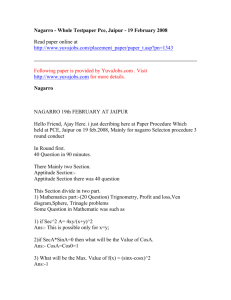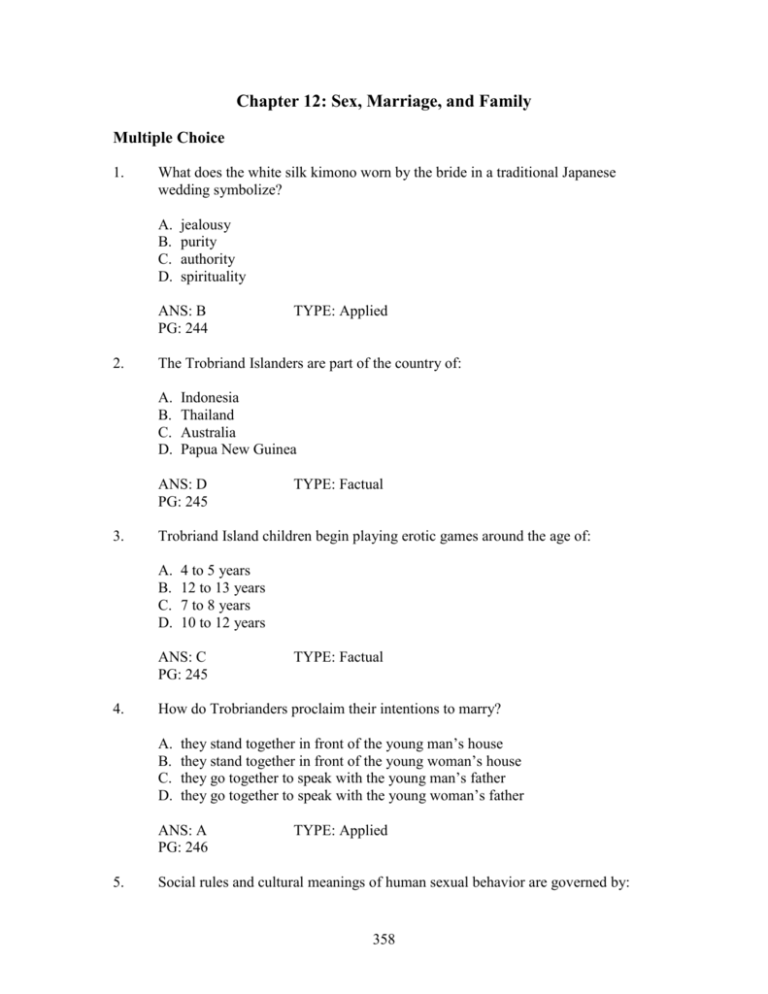
Chapter 12: Sex, Marriage, and Family
Multiple Choice
1.
What does the white silk kimono worn by the bride in a traditional Japanese
wedding symbolize?
A.
B.
C.
D.
jealousy
purity
authority
spirituality
ANS: B
PG: 244
2.
The Trobriand Islanders are part of the country of:
A.
B.
C.
D.
Indonesia
Thailand
Australia
Papua New Guinea
ANS: D
PG: 245
3.
4 to 5 years
12 to 13 years
7 to 8 years
10 to 12 years
ANS: C
PG: 245
TYPE: Factual
How do Trobrianders proclaim their intentions to marry?
A.
B.
C.
D.
they stand together in front of the young man’s house
they stand together in front of the young woman’s house
they go together to speak with the young man’s father
they go together to speak with the young woman’s father
ANS: A
PG: 246
5.
TYPE: Factual
Trobriand Island children begin playing erotic games around the age of:
A.
B.
C.
D.
4.
TYPE: Applied
TYPE: Applied
Social rules and cultural meanings of human sexual behavior are governed by:
358
Sex, Marriage, and Family
A.
B.
C.
D.
individual behavior
hormones only
biology
culture
ANS: D
PG: 246
6.
According to strict Judeo-Christian law, as prescribed in the book of Leviticus,
adultery was punishable by:
A.
B.
C.
D.
incarceration
flogging
social ostracism
death
ANS: D
PG: 247
7.
flogging
social ostracism
death
exile
ANS: B
PG: 247
TYPE: Applied
In which famous novel was adultery among Christian colonists in New England
explored?
A.
B.
C.
D.
Pilgrim’s Progress
The House of Seven Gables
The Odyssey
The Scarlet Letter
ANS: D
PG: 247
9.
TYPE: Applied
Among Christian colonists in 17th- and 18th-century New England, adultery by
women often led to:
A.
B.
C.
D.
8.
TYPE: Conceptual
TYPE: Conceptual
Under Shariah law, women found guilty of having sexual relations outside of
marriage were sentenced to:
A. wearing a letter on their attire
359
Test Bank: Chapter 12
B. exile
C. death
D. social ostracism
ANS: C
PG: 247
10.
The worldwide epidemic of HIV/AIDS has had:
A.
B.
C.
D.
no impact on worldwide sexual behavior
little impact in societies with few sexual restrictions
great impact especially in sexually restrictive societies
relatively little impact in sexually restrictive societies
ANS: D
PG: 247
11.
55%
35%
5%
15%
ANS D
PG: 248
TYPE: Factual
In the United States, approximately what percentage of children under 18 years
has been involved in incestuous relations?
A.
B.
C.
D.
2 to 3%
14 to 15%
4 to 10%
10 to 14%
ANS: D
PG: 248
13.
TYPE: Conceptual
What percentage of known societies have rules requiring that sexual involvement
take place only within marriage?
A.
B.
C.
D.
12.
TYPE: Applied
TYPE: Factual
In a sample study of 129 societies, Nancy Thornhill found that the most common
incest taboo was between:
A.
B.
C.
D.
cousins
siblings
parent and child
grandparent and child
360
Sex, Marriage, and Family
ANS: A
PG: 248
14.
Which of the following statements about incest is most accurate?
A.
B.
C.
D.
just as marriage in various forms is found in all cultures, so is the incest taboo
there are essentially two incest taboos found in different cultures
there is only one incest taboo found in all cultures
every religion has only one incest taboo
ANS: A
PG: 248
15.
it does not cause a significant increase in genetic deficiency
it causes significantly increased genetic risks
it produces unhealthy children
it is a threat to civilized life
ANS: A
PG: 250
siblings
father and child
mother and child
first cousins
ANS: D
PG: 248
TYPE: Conceptual
Sexual relations among adolescent Trobriand Islanders are:
A.
B.
C.
D.
absolutely prohibited until the age of 25
restricted to young males only
relaxed and involve experimental alliances
open only to specific social classes
ANS: C
PG: 249
18.
TYPE: Applied
Most societies include in the incest taboo a prohibition against sexual relations
between all of the following except:
A.
B.
C.
D.
17.
TYPE: Factual
Which of the following statements is true regarding first-cousin marriage?
A.
B.
C.
D.
16.
TYPE: Factual
TYPE: Applied
Which of the following statement is true?
361
Test Bank: Chapter 12
A.
B.
C.
D.
most societies are neither exogamous nor endogamous
a society that is highly developed is exogamous
a society that has sexual restriction can be classified as endogamous
a society may have both exogamous and endogamous rules
ANS: D
PG: 249
19.
Currently, first cousin marriage is illegal in how many states in the United States?
A.
B.
C.
D.
none
19
31
50
ANS: C
PG: 249
20.
social alliance
sexual control
healthy children
urbanization
ANS: A
PG: 249
TYPE: Conceptual
If you were restricted to marrying your mother’s brother’s sons or daughters, then
you would be _______________ for marriage of _______________.
A.
B.
C.
D.
endogamous/cross-cousins
endogamous/parallel cousins
exogamous/cross-cousins
exogamous/parallel cousins
ANS: A
PG: 249
22.
TYPE: Factual
According to early anthropologists, the primary purpose of exogamy was to
promote:
A.
B.
C.
D.
21.
TYPE: Conceptual
TYPE: Applied
All of the following are forms of marriage except:
A. polygyny
B. monogamy
C. sororal polyandry
362
Sex, Marriage, and Family
D. polygamy
ANS: C
PG: 249-257
23.
What is the great “myth” that is commonly held in North American regarding the
reason for the establishment of a taboo against first-cousin marriage in the United
States?
A.
B.
C.
D.
it is a religious prohibition
it decreased the chances for the family to extend social alliances
it would incite feuding within the nuclear family
it would cause increased numbers of birth defects
ANS: D
PG: 250
24.
15th century
21st century
18th century
19th century
ANS: D
PG: 250
TYPE: Conceptual
Polygyny is favored by what percentage of the world’s cultures?
A.
B.
C.
D.
20%
40%
60%
80%
ANS: D
PG: 250
26.
TYPE: Conceptual
During what time period were first-cousin marriage prohibitions developed in the
United States?
A.
B.
C.
D.
25.
TYPE: Factual
TYPE: Factual
Why does the number of monogamous marriages often exceed polygynous ones
in cultures where polygyny is preferred?
A.
B.
C.
D.
social sanctions
lack of economic resources
illegal status
lack of women
363
Test Bank: Chapter 12
ANS: B
PG: 250
27.
In most polygynous societies, women:
A.
B.
C.
D.
have bargaining power and some independence
are extremely subordinated
enjoy equal status with men
are in the highest social positions
ANS: A
PG: 251
28.
monogamy
polyandry
polygamy
serial monogamy
ANS: D
PG: 251
serial monogamy
polyandry
polygamy
polygyny
ANS: D
PG: 250
TYPE: Factual
What is the official position of the Mormon Church in regards to polygamy?
A.
B.
C.
D.
it is openly encouraged in the press and from the pulpit
it is not an officially approved practice
it is required
it is accepted in certain cases in which the husband can provide well for his
family
ANS: B
PG: 252
31.
TYPE: Factual
Marriage in which a man has more than one wife is called:
A.
B.
C.
D.
30.
TYPE: Conceptual
What do we term the type of marriage in which each partner has just one spouse,
but marries a series of partners in succession?
A.
B.
C.
D.
29.
TYPE: Conceptual
TYPE: Applied
Which of the following societies is traditionally polyandrous?
364
Sex, Marriage, and Family
A.
B.
C.
D.
English
Samoan
Trobriand Islanders
Nyimba of Nepal
ANS: D
PG: 252
32.
The simultaneous marriage of several brothers to a single wife is called:
A.
B.
C.
D.
fraternal polyandry
fraternal monogamy
fraternal polygyny
fraternal polygamy
ANS: A
PG: 252
33.
sororal marriage
sororal monogamy
sororal polyandry
sororal polygyny
ANS: D
PG: 252
TYPE: Factual
A patrilateral parallel-cousin marriage is between a man and his:
A.
B.
C.
D.
mother’s brother’s daughter
father’s brother’s daughter
father’s son’s daughter
father’s father’s daughter
ANS: B
PG: 253
35.
TYPE: Factual
When co-wives are sisters, it is called
A.
B.
C.
D.
34.
TYPE: Factual
TYPE: Applied
Patrilateral parallel-cousin marriages were historically and traditionally favored
among all of the following except:
A.
B.
C.
D.
ancient Israelites
ancient Greeks
Romans
Arabs
365
Test Bank: Chapter 12
ANS: C
PG: 253
36.
Which form of residence is traditional among urban, upper-middle class Indian
couples?
A.
B.
C.
D.
patrilocal
matrilocal
neolocal
bilocal
ANS: A
PG: 254
37.
never practiced
always practiced
still somewhat common among certain social classes
extremely common among the lower castes
ANS: C
PG: 254
TYPE: Applied
The marriage of a woman to her father’s sister’s son is called:
A.
B.
C.
D.
matrilateral cross-cousin marriage
matrilateral parallel-cousin marriage
patrilateral cross-cousin marriage
patrilateral parallel-cousin marriage
ANS: A
PG: 256
39.
TYPE: Applied
In India, arranged marriages are:
A.
B.
C.
D.
38.
TYPE: Conceptual
TYPE: Factual
Among the Nandi, which person is considered the “female husband”?
A.
B.
C.
D.
the barren woman who contracts the marriage
the fertile woman who enters into woman to woman marriage
the husband of the barren woman
the male lovers of the fertile woman
ANS: A
PG: 256
TYPE: Applied
366
Sex, Marriage, and Family
40.
All of the following are considered assets in a woman to woman marriage among
the Nandi except:
A.
B.
C.
D.
the barren woman is able to divorce her first husband
a barren woman obtains sons for inheritance
each woman obtains a higher status than would be otherwise
the female husband is less harsh and demanding
ANS: A
PG: 256
41.
Which of the following arguments is not commonly used against same-sex
marriage?
A.
B.
C.
D.
it is not representative of traditional marriage
it indicates support for gays and gay lifestyle
it destroys the social and economic basis of society
it does not produce children
ANS: C
PG: 257
42.
bride service
bride-price
dowry
bridewealth
ANS: C
PG: 257
TYPE: Applied
What is the rationale for bridewealth in a patrilineal society?
A.
B.
C.
D.
the wife is expensive to maintain and the groom must be compensated
the wife’s family will lose her labor and reproductive capacity
the wife’s family negotiates a better marriage with a high bridewealth
the wife’s children will drain resources from her husband’s family over time
ANS: B
PG: 257
44.
TYPE: Conceptual
The United States’ custom of the bride’s family paying for the wedding expenses
is:
A.
B.
C.
D.
43.
TYPE: Conceptual
TYPE: Conceptual
In which American Indian group can a woman divorce her husband by placing his
belongings outside of the door?
367
Test Bank: Chapter 12
A.
B.
C.
D.
Mattaponi
Pamunkey
Crow
Hopi
ANS: D
PG: 258
45.
Which of the following is a significant reason for lower divorce rates prior to
1800 in Western societies?
A.
B.
C.
D.
more material possessions and more children in marriages
a high mortality rate
men and women did not argue as much as they do now
women were more valuable than they are now
ANS: B
PG: 258
46.
grandparents
both mothers and fathers
fathers and older brothers
mothers and younger siblings
ANS: D
PG: 259
TYPE: Applied
The basic residential unit where economic production, consumption, inheritance,
child rearing and shelter are organized is called the:
A.
B.
C.
D.
household
family
conjugal unit
marriage
ANS: A
PG: 259
48.
TYPE: Conceptual
Among the Mundurucu, until the age of 13 all children live exclusively with their:
A.
B.
C.
D.
47.
TYPE: Applied
TYPE: Factual
Families that are established through marriage are called:
A.
B.
C.
D.
nuclear
conjugal
for monetary profit
blended
368
Sex, Marriage, and Family
ANS: B
PG: 260
49.
According to a cross-cultural survey of 192 families, the most common family is:
A.
B.
C.
D.
nuclear
extended
conjugal
polygamous
ANS: B
PG: 260
50.
20
60
45
90
ANS: A
PG: 260
TYPE: Applied
Which of the following is considered primarily responsible for raising children
among the Inuit?
A.
B.
C.
D.
siblings only
the extended family
the wife in a nuclear family
all adult members of the community
ANS: C
PG: 261
52.
TYPE: Applied
In the United States, what percentage of families is considered to be “nuclear”
today?
A.
B.
C.
D.
51.
TYPE: Factual
TYPE: Factual
The nuclear family is especially well adapted to a mode of subsistence that
requires:
A.
B.
C.
D.
healthy children
accumulated wealth
a large labor force
a high degree of geographical mobility
ANS: D
PG: 261
TYPE: Conceptual
369
Test Bank: Chapter 12
53.
The most common family type in traditional farming and herding cultures is the:
A.
B.
C.
D.
conjugal family
nuclear family
extended family
blended family
ANS: C
PG: 261
54.
A family established through marriage is called a:
A.
B.
C.
D.
consanguineal family
conjugal family
nuclear family
group family
ANS: B
PG: 260
55.
TYPE: Conceptual
TYPE: Factual
In the United States, new reproductive technologies and open adoption have
contributed to the rise of:
A.
B.
C.
D.
polygamous families
extended families
nuclear families
blended families
ANS: D
PG: 263
TYPE: Applied
True/False
56.
All societies have rules to govern sexual behavior.
ANS: True
PG: 244
57.
Among Trobriand Islanders, sexual relations are not permitted before marriage.
ANS: False
PG: 245
58.
TYPE: Factual
TYPE: Factual
Sexually restrictive societies are in a worldwide minority.
370
Sex, Marriage, and Family
ANS: True
PG: 248
59.
The incest taboo is a permanent cultural law.
ANS: False
PG: 248
60.
TYPE: Factual
If a marriage in which bridewealth has been paid is dissolved, the money must be
returned to the bride’s family.
ANS: False
PG: 257
67.
TYPE: Conceptual
Bridewealth (bride-price) is associated with patrilineal societies.
ANS: True
PG: 257
66.
TYPE: Factual
Most societies worldwide allow individuals to choose their own spouse.
ANS: False
PG: 253
65.
TYPE: Factual
Polygamy is prohibited in England.
ANS: False
PG: 252
64.
TYPE: Conceptual
First-cousin marriage causes significant increases in genetic deficiency.
ANS: False
PG: 250
63.
TYPE: Conceptual
There is no difference between marriage and mating.
ANS: False
PG: 249
62.
TYPE: Conceptual
In societies where there is a strict incest taboo, you do not find sexual violations.
ANS: False
PG: 248
61.
TYPE: Factual
TYPE: Applied
Divorce did not occur before urbanization.
371
Test Bank: Chapter 12
ANS: False
PG: 258
68.
The structures of marriage and the family are cultural phenomena.
ANS: True
PG: 259
69.
TYPE: Factual
In matrilocal residence the groom’s family does not usually receive marriage
compensation.
ANS: True
PG: 263
74.
TYPE: Factual
Anthropologists have identified five kinds of post-marital residence.
ANS: True
PG: 263
73.
TYPE: Factual
Single-parent households are a phenomenon associated only with post-industrial
societies.
ANS: False
PG: 262
72.
TYPE: Factual
The smallest known family unit is the nuclear family.
ANS: True
PG: 260
71.
TYPE: Conceptual
A nuclear family contains one or two parents and their immediate offspring.
ANS: True
PG: 260
70.
TYPE: Factual
TYPE: Applied
China has more than 114 million migrant workers.
ANS: True
PG: 264
TYPE: Factual
Fill in the Blank
75.
In traditional Muslim societies ______________ law regulates social behavior in
strict accordance with religious standards of morality.
372
Sex, Marriage, and Family
ANS: Shariah
PG: 247
76.
In much of North America and Europe, the traditional ideal was that all sexual
activity outside of marriage was _______________.
ANS: taboo
PG: 248
77.
TYPE: Conceptual
The marriage of one woman to two or more men simultaneously is called
_______________.
ANS: polyandry
PG: 252
83.
TYPE: Factual
The most preferred form of marriage in the world is _______________.
ANS: polygamy or polygyny
PG: 249
82.
TYPE: Applied
Rules for marriage outside of a group are called _______________.
ANS: exogamy
PG: 249
81.
TYPE: Factual
In Peru, the Inca was required to marry his _______________.
ANS: sister
PG: 248
80.
TYPE: Factual
The absolute forbiddance of sexual contact between certain close relatives is an
__________________________.
ANS: incest taboo
PG: 248
79.
TYPE: Conceptual
The anthropological definition of marriage says that it establishes
_______________ and _______________ between various people involved.
ANS: rights, obligations
PG: 248
78.
TYPE: Applied
TYPE: Factual
Co-marriage is also known as __________________________.
ANS: group marriage
PG: 253
TYPE: Factual
373
Test Bank: Chapter 12
84.
On an anthropological kinship chart, the symbol used for a female is always a
_
.
ANS: circle
PG: 253
85.
In arranged marriages in India, the groom and bride tend to be from the same
_______________.
ANS: caste (sub-caste)
PG: 254
86.
TYPE: Factual
In situations where men play a predominant role in subsistence, you would expect
to find _______________ residence.
ANS: patrilocal
PG: 263
91.
TYPE: Conceptual
In a cross-cultural survey of 192 cultures, the _______________ family was
found to be the least common.
ANS: polygamous
PG: 260
90.
TYPE: Conceptual
The smallest family unit is the _______________ family.
ANS: nuclear
PG: 260
89.
TYPE: Factual
The basic cooperative structure that ensures an individual’s primary needs and
provides the necessary care for children is the _______________.
ANS: family
PG: 259
88.
TYPE: Applied
Payments of money or valuable good to the bride’s parents or other close kin is
called _______________.
ANS: bridewealth (or bride-price)
PG: 257
87.
TYPE: Factual
TYPE: Applied
When a married couple forms a household in a separate location it is
_______________ residence.
ANS: neolocal
TYPE: Factual
374
Sex, Marriage, and Family
PG: 263
92.
Traditionally, among the Hopi Indians, _______________ residence was
commonly practiced.
ANS: matrilocal
PG: 263
TYPE: Applied
Short Answer
93.
What three challenges do marriage and family resolve for human societies?
ANS: They resolve the challenge of managing sexual relations, establishing social
alliances essential to survival, and raising children.
PG: 246
TYPE: Conceptual
94.
What is the anthropological definition of marriage?
ANS: Marriage is a culturally sanctioned union between two or more people that
establishes certain rights and obligations between the people, between them and
their children, and between them and their in-laws.
PG: 248
TYPE: Factual
95.
What are the biological consequences of incest and the incest taboo?
ANS: Biologically, incest leads to increased percentage of desirable and
undesirable characteristics; it is a selective force. The incest taboo prevents the
harmful effects of inbreeding.
PG: 248
TYPE: Applied
96.
Describe gender roles in a typically polygynous society.
ANS: A typical polygynous society is one that supports itself through cultivation
in which women do the bulk of the work and child are highly valued. Often
women have strong bargaining positions in a polygynous household and some
degree of independence.
PG: 252
TYPE: Applied
97.
What is the adaptive value of fraternal polyandry?
ANS: It prevents land subdivision among sons, holds down population growth,
and provides an adequate pool of male labor.
375
Test Bank: Chapter 12
PG: 252
TYPE: Applied
98.
Under what conditions did we find group marriage among the Eskimos of
northern Alaska?
ANS: It provided mutual aid and support when a man lent his wife and was found
associated with hunting crews on whaleboats in which a man sealed his
partnerships with the crew members by loaning his wife.
PG: 253
TYPE: Conceptual
99.
Under what conditions is woman to woman marriage practiced among the Nandi,
and what are the advantages of such an arrangement?
ANS: It is found among barren women in polygynous households. The
advantages of woman to woman marriage are that the barren woman raises her
status substantially by producing male heirs through her female partner; the fertile
woman raises her status and secures legitimacy for her offspring, and the
relationship overall is usually less harsh and demanding.
PG: 256
TYPE: Applied
100.
How is same-sex marriage culturally adaptive among the Nandi?
ANS: It is used to allow women who have no sons an opportunity to form a
family with a younger woman and function as an economic and social unit.
PG: 256
TYPE: Applied
101.
Distinguish between bride-price and bride service.
ANS: Bride-price is money transferred to the bride’s family upon marriage, while
bride service involves a designated period of work that the groom does for the
bride’s family.
PG: 257
TYPE: Factual
102.
What advantages does dowry confer on a woman?
ANS: She gains more influence within her marriage, she is able to influence the
choice of husband, she has some financial security after the death of her spouse,
and it affords some protection against desertion by the male.
PG: 257
TYPE: Conceptual
376
Sex, Marriage, and Family
103.
Define the anthropological concept of family.
ANS: Family is two or more people related by blood, marriage, or adoption.
PG: 260
TYPE: Factual
104.
What are the primary forces that have shaped the nuclear family in the United
States during the past 50 years?
ANS: The primary forces are industrialization and job mobility, changing social
norms about the independence of offspring, and the availability of retirement
homes and alternative non-extended family options for older parents and
grandparents.
PG: 261
TYPE: Applied
Essay
105.
Marriages often contain economic components and in some cases may be
arranged by parents or families; however, some second generation immigrants
growing up in the United States are often conflicted on this practice. While their
parents may have had an arranged marriage, second or third generation
immigrants are often confronted with or are surrounded by concepts of romantic
love. Discuss how generational differences among immigrant communities may
result in children challenging their parents’ attempts to arrange their marriages.
ANS: Will vary
106.
The increasing rate of divorce in the United States and other Western industrial
and postindustrial societies have many people worried about the future of family
and household structures. Yet others argue that the divorce rates, while higher in
part, have been exaggerated for specific political purposes (e.g. to return to a more
‘traditional’ family structure). What are the patterns of divorce in the United
States? How have such patterns been explained? Why have some argued against
the increases in divorce and the rise of nonfamily/nontraditional households?
How many people do you know that reside in nontraditional families?
ANS: Will vary
107.
This chapter closes with a brief look at “Family in our Globalized and
Technologized World.” Topics briefly mentioned here range from blended
families to immigrant communities to in vitro fertilization. Undoubtedly,
immigrant populations have, in some cases, challenged some traditional notions
on family, marriage, and sex. Discuss the changes that might be anticipated
within a country such as the United States if marriage and residence patterns were
to shift.
377
Test Bank: Chapter 12
ANS: Will vary
108.
What is the anthropological definition of marriage? Using this definition,
describe what each aspect of it means and how it contributes to cultural
adaptation.
ANS: Will vary
378

